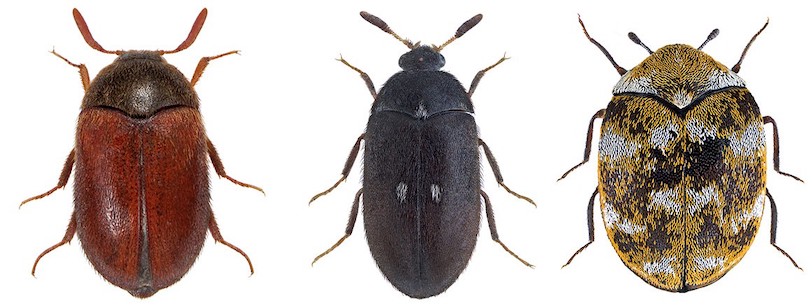
You found a bug. Is it a bed bug or just one of the bugs that look like bed bugs? You’ll want to find out for sure because the answer will determine your next course of action.
And trust us: if it’s bed bugs, you’re going to want to get started like NOW.
So, without further ado, let’s identify the bug that’s been giving you grief.
7 Bugs that Look Like Bed Bugs
Bed bugs are horrible pests to be burdened with. These small creatures feed solely and exclusively on blood and show a marked preference for human blood. If it helps, you could think of them as a species of tiny six-legged Draculas, but without the cape or the aristocratic manners. So not really like Dracula or at all, then.
Okay, so we’ve covered how to tell a bed bug from an Eastern European vampire. That was a quick article, you may be thinking. Though a helpful one, clearly written by a talented and attractive individual. But wait! There’s more!
Besides Dracula, there are a few more creatures that can be mistaken for bed bugs. So if you find a bug in your house that you think may be a bed bug, take a closer look.
Before you set fire to your bedding and resign yourself to living out the rest of your days in a stainless steel cubicle, you may not have bed bugs at all. The bug you found may instead be one of these bed bug lookalikes.
Bed Bug vs Carpet Beetle
Bed bugs and carpet beetles have very different diets and lifestyles. But they’re both quite small and you may find them near the places where bed bugs also like to hide, which can result in confusion.
Let’s clear that up.
What are Carpet Beetles?
These bed bug lookalikes are small hard-bodied bugs, up to 3/16 of an inch in size. That makes them smaller than a bed bug, which are closer to 1/4 of an inch when fully grown.
Carpet beetles can fly and have wings that they keep hidden under rigid wing cases. They have their heads tucked underneath their bodies, which can make them appear headless when seen from above.
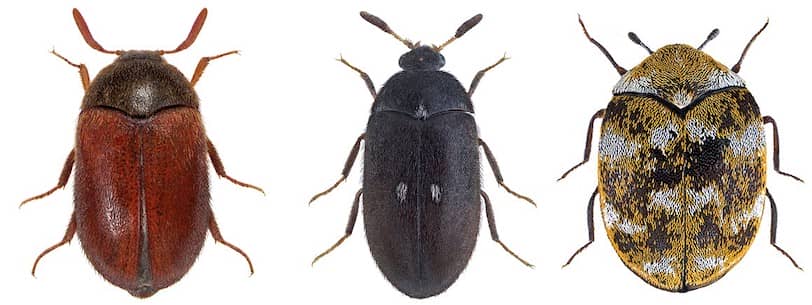
As you may have noticed, carpet beetles don’t really look very much like bed bugs at all. Nevertheless, they are one of the most commonly misidentified bugs out there.
This is because, again unlike bed bugs, carpet beetles undergo complete metamorphosis. This means that the larvae, the young beetles, look nothing like the adults. The larvae have no limbs and look like little worms covered in long hair-like structures that make them appear fuzzy.
It’s the larvae, incidentally, that feed on carpet fibers and give the species its name.
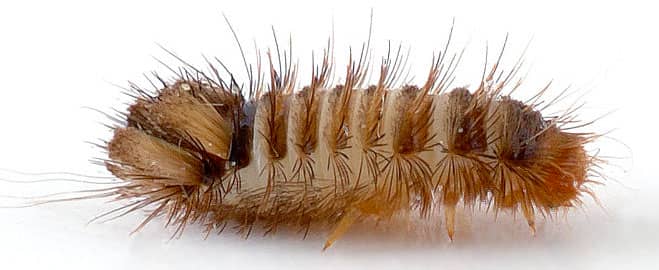
The larvae like to live near fabric. The underside of sofas and beds are a common place to find them, along with areas where furniture sits on top of carpet. These are similar to the places that bed bugs are often found.
Furthermore, in order to grow, carpet beetle larvae shed their skin via a process called molting. Bed bugs do the same. The shed skins bed bugs leave behind can be a sign of infestation.
But at roughly the same size and with the same sort of orangey color, the shed skins of juvenile carpet beetles can look similar to those of bed bugs.
The Key Difference Between Bed Bugs and Carpet Beetles
Adult carpet beetles and adult bed bugs look almost nothing like each other. Different in size, color, and behavior, it’s not hard to tell one from the other.
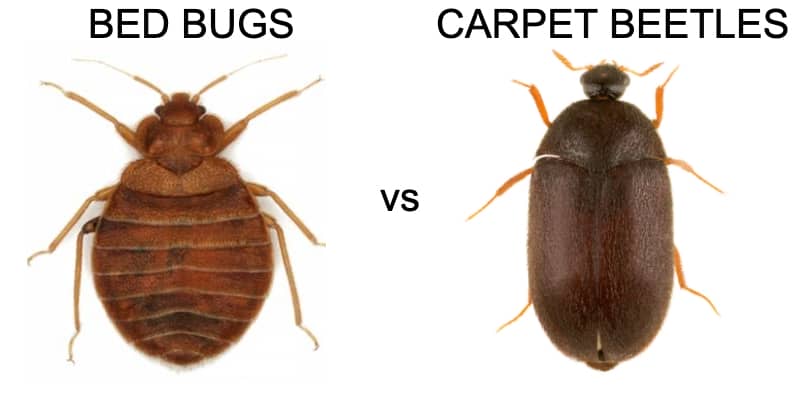
When dealing with the molted skins, though, things get a little trickier. So if you want a surefire way to identify which bug you’re dealing with, ignore molted skins, roll up your sleeves and go searching.
If you find any caterpillar-like insects, it’s definitely carpet beetles since bed bugs never resemble worms at any stage of their life cycle.
One last tip: if you can find damage to carpets and other natural fabrics – it’s also more likely to be carpet beetles since bed bugs only diet is warm blood. Want a more in-depth guide to bed bugs vs carpet beetles? Check out the below article.
>>>Bed Bugs vs Carpet Beetles: 5 Ways to Tell the Difference
Bed Bug vs Roach
It’s not difficult differentiating between a cockroach and bed bug. But where it gets tricky is when it comes to cockroach nymphs and bed bugs.
What are Cockroach Nymphs?
When talking about insects, which both bed bugs and cockroaches are, the juvenile stages are known as nymphs. Both cockroaches and bed bugs undergo incomplete metamorphosis, which means that the young bugs look similar to the adults.
Baby bed bugs look like big bed bugs, but don’t try to say that five times fast.
However, the juveniles of the German cockroach – which just so happens to be the world’s most widespread cockroach species – can look at first glance like bed bugs. Especially if you don’t look too closely – and who would want to?
However, the biology and behavior of these two hated pests is quite different, so it’s important to be able to tell one from the other. That means you’re probably going to need to take a closer look.
The Key Difference Between a Bed Bug and a Roach
Bed bugs are roughly oval in shape, tapering toward the head. This makes them look almost like an apple seed. Also, bed bugs take on a reddish-brown color from the blood that they eat.
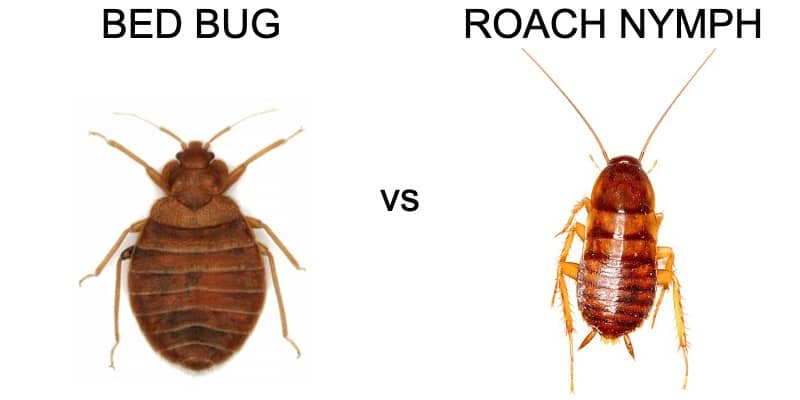
Cockroaches are longer and more cylindrical. Also, they are browner in color, varying from tan to almost black, but without the red hue of a bed bug. Additionally, cockroaches have much longer and more mobile antenna than bed bugs.
Also, the place where you found the bug can give you a clue as to what it is. Cockroaches, especially the juvenile type that more closely resemble bed bugs than the adults, are generally found close to sources of water.
Kitchens and bathrooms are their favorite haunts. On the other hand, bed bugs prefer bedrooms and living rooms. While they can be found anywhere in the home, kitchens and bathrooms are some of the least likely places you’ll find them.
Bed Bugs vs Spider Beetles
Both bed bugs and spider beetles have a reddish hue and prefer to operate by cover of night. The good news is that once you know their main habits, you can easily tell them apart.
What are Spider Beetles?
Spider beetles are round, red beetles that are often confused with bed bugs because of their color and shape. Thanks to their reddish color, it’s easy to think that these little buggers have just sucked some blood when first encountering them.
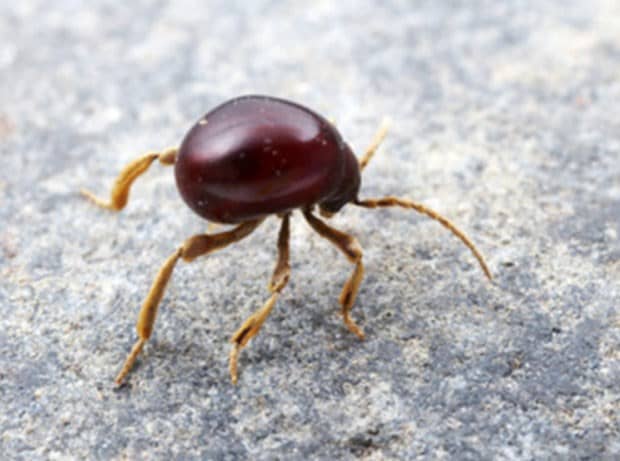
But look a little closer and you’ll see that spider beetles look a lot like a spider (thus the name, duh). But the resemblance stops there. These beetles are insects just like bed bugs, which means they have six legs.
However, their long antenna can look like an additional pair of legs, which is what gets them compared with spiders.
The Key Difference Between Bed Bugs and Spider Beetles
Spider beetles are usually a little smaller than adult bed bugs. Also, their legs are longer in comparison to their bodies than those of a bed bug. Furthermore, bed bugs have a distinctive shape when looked at from the side.
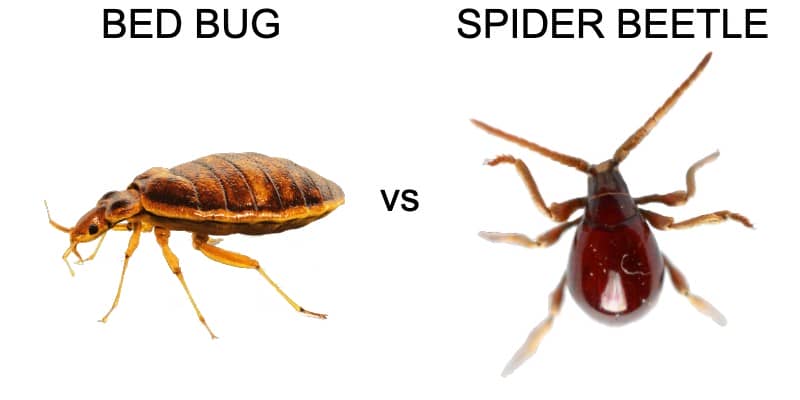
They are flattened across the top, which allows them to hide in cracks and crevices around the home. The body of the spider beetle is much more spherical.
Also, like cockroaches, spider beetles are interested in human food, not blood. They are most commonly found in kitchens and food preparation establishments, and you would be very unlucky to find one of these creatures in your bed.
Booklice vs Bed Bugs
Adult bed bugs and booklice are easy to tell apart. So why are they so easily confused for each other? Well, juvenile bed bugs look a lot like booklice.
What are Booklice?
These tiny bugs are around 1 mm long, which makes them close in size to a newly hatched juvenile bed bug. Also, like a baby bed bug, booklice are transparent. It’s only feeding on blood that gives bed bugs their reddish-brown color.
Booklice don’t bite people, so they stay see-through just like a juvenile bed bug.
The Key Difference Between Booklice vs Bed Bugs
You’re going to need a magnifying glass for this one. Both juvenile bed bugs and booklice are very hard to see without some optical assistance. But if you do get a good look at one, pay attention to the shape of their bodies.
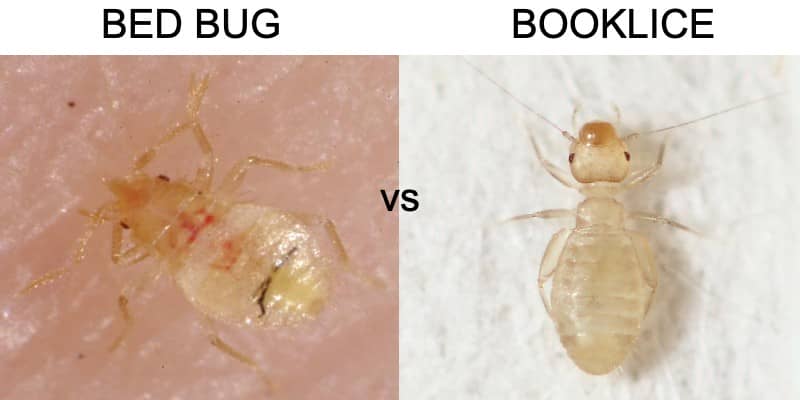
Booklice are longer than juvenile bed bugs, and have a wider head compared to their body. They also have a narrow waist, whereas bed bugs get progressively wider from the head down.
If you want to skip peering too closely at these creepy crawlies, a key giveaway is where you find them. If you find something that could be a booklice or a juvenile bed bug living close to where you sleep or spend a lot of your time, like your bed or sofa, it’s most likely bed bugs.
Ditto if you’re getting bites, since booklice don’t bite people.
Instead, booklice prefer to feast on things like microscopic mold that grows on damp food, damp cardboard, or even on book bindings (thus their name). So you’re most likely to find them in kitchen cupboards, under kitchen appliances, or inside books and magazines.
Bed Bugs vs Bat Bugs
Out of all the bugs that look like bed bugs, bat bugs are definitely the trickiest to identify. That is, if you’re only relying on looks…
What are Bat Bugs?
Unfortunately, these creatures didn’t get their name from their regular attendance at baseball games. Instead, they feed on the blood of bats in much the same way as bed bugs feed on the blood of humans.
In fact, the two species are very closely related. One theory of bed bug evolution is that they started out as bat bugs, and learned to feed on humans back when we lived in bat-infested caves. Good thing that’s behind us, huh?
The Key Difference Between Bed Bugs vs Bat Bugs
As we mentioned, when it comes to bed bug lookalikes, this one is tricky. To the naked eye, bat bugs look almost identical to bed bugs. They’re the same size, the same body shape, the same color. As a result, it’s very difficult to tell these creatures apart.
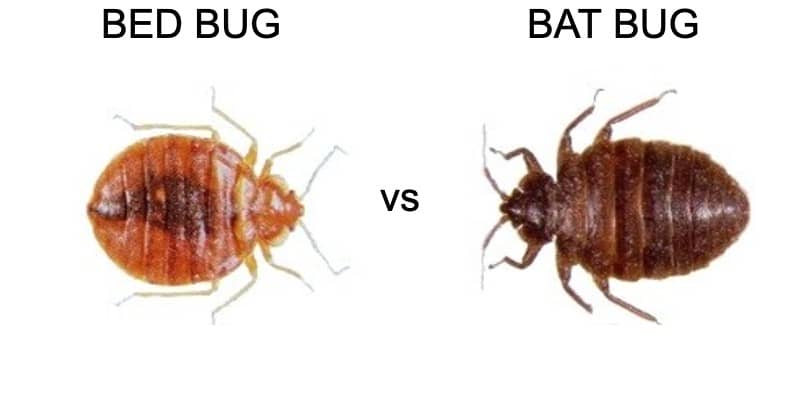
Under a microscope, bat bugs have a more hairy appearance than their bed bug cousins. There are also some highly technical differences concerning the ratio of body size to antenna segments, which there’s not much point concerning yourself with unless you’re planning to make a career out of bugs.
But the most important thing to remember is that while bat bugs can and sometimes do bite people, they won’t make a habit of it the way bed bugs do. Generally, bat bugs bite once the bats they have been feeding on migrate, and the only food source they have left in a home is humans.
Bed bugs, on the other hand, will bite you whenever they feel like it.
Bed Bugs vs Fleas
Welcome to yet another round of bugs that look like bed bugs. With fleas, it can be particularly confusing since they’re both very small and they both love to drink your blood. Lucky for us, the similarities pretty much stop there.
What are Fleas?
Fleas are tiny bugs around 1/8 of an inch long when fully grown. They are usually dark brown to black but can take on more of a red shade when they are full of blood.
Just like bed bugs, they feed on blood and leave itchy red welts behind when they bite.
Fleas don’t really look anything like bed bugs, but it’s the bites they cause that often lead to a case of mistaken identity. While some people claim to be able to tell the difference between the bed bug bites vs flea bites, it’s hard to believe given that every individual will react differently.
Identifying a bug from its bite is like trying to guess someone’s hair color from looking at their footprint.
The Key Difference Between Bed Bugs vs Fleas
If you actually see a flea, you’ll know right away that it isn’t a bed bug. Wrong size, wrong color, wrong shape.

But there are two crucial ways to really tell them apart:
- Do they jump? Fleas are champion jumpers whereas bed bugs are confined to walking. So if you see one of these bugger jumping – it’s fleas.
- Where are the bites? Bed bugs usually bite in clusters and they do so mostly under cover of darkness. Fleas will bite you anytime, anywhere and remember – they jump. So if you’re getting a bunch of bites around your ankles, it’s probably fleas.
However, if you’re just getting bites and haven’t seen any bugs, there is one way to rule out the possibility of fleas. With a dish of soapy water and a light source such as a lamp, you can build a cheap and effective flea trap.
Set the dish of soapy water on a carpeted area of your home, ideally close to where pets sleep. Shine the light on the water and leave it overnight. Fleas are attracted to light and will jump toward it. When they land in the water, they will drown, and you’ll find them in the dish the next morning.
If you find some fleas in the dish, chances are your bites came from them. If you don’t, you may have to consider the possibility that is bed bugs that are biting you, not fleas. But remember: even if you find fleas, that doesn’t rule out the possibility that you have bed bugs too. Maybe you really are that unlucky.
Clover Mites vs Bed Bugs
Clover mites and bed bugs are actually really easy to tell apart and yet when you’re dealing with such tiny species, it can get confusing. So here’s how to tell for sure.
What are Clover Mites?
Clover mites get their name from feeding on clover. This means that they are usually an outdoor pest, but they can sometimes be found indoors, especially in autumn, when the weather starts to cool.
Their red color means that they are sometimes mistaken for bed bugs. Everybody knows that bed bugs are red (from our blood), so it’s not unusual for any red bug to be mistaken for a bed bug.
The Key Difference Between Clover Mites vs Bed Bugs
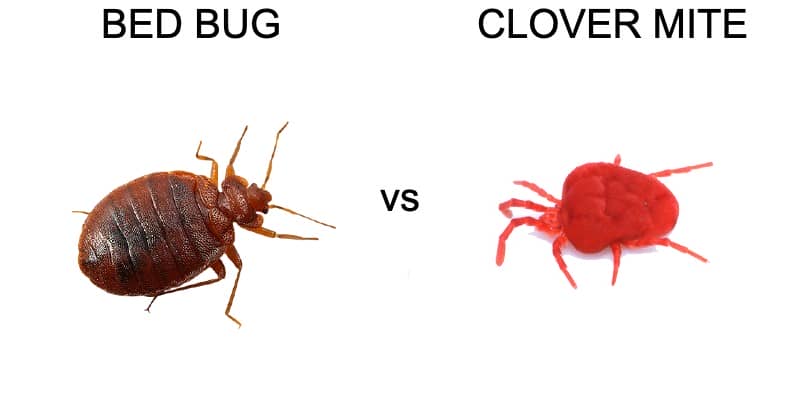
At 1/64 of an inch long, clover mites are much smaller than bed bugs. And although their body has a similar shape, their red color is usually much brighter than that of a bed bug. In the sun, they are very bright, almost neon.
Finally, mites are arachnids, meaning they have eight legs. Bed bugs, as insects, only have six.
So, have you identified your bed bug lookalike? Or maybe you’ve come to the unfortunate realization that you have bed bugs. If it’s the latter, you’ll want to get started solving that problem ASAP. Here’s everything you need to know about bed bugs.
